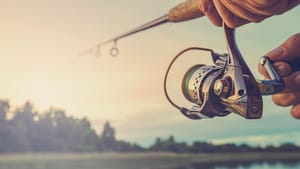Fishing is both an art and a science, requiring skill, patience, and the right equipment. One critical aspect of a fishing reel that often goes unnoticed by beginners but is paramount for seasoned anglers is the max drag. Understanding what max drag is and how it functions can be the difference between a successful catch and a fishing tale about the one that got away.
Key Takeaways:
- Max drag refers to the maximum amount of resistance a fishing reel can exert on a hooked fish without breaking the line.
- Knowing how to adjust and use the drag system can significantly improve your fishing technique and success rate.
- Proper maintenance and understanding of your reel's drag system can extend the life of your fishing gear.
The Basics of Fishing Reel Drag
The drag system of a fishing reel is essentially a set of friction plates that apply pressure to the reel spool, allowing it to release line under tension. This mechanism is crucial when battling a fish that is trying to swim away, as it prevents the line from breaking by letting out line under controlled tension. The max drag is the highest tension setting on this system.
When discussing what is max drag in a fishing reel, it's important to note that it is measured in pounds. The max drag rating indicates the highest amount of force the reel can exert on the fish without compromising the integrity of the line. This rating is crucial when targeting larger species, as a reel with a higher max drag will be able to handle bigger, stronger fish.
Types of Drag Systems
There are two main types of drag systems found in fishing reels: front drag and rear drag. Front drag systems are typically found on spinning reels and are known for their durability and strength. They are adjusted using a dial located on the front of the spool. Rear drag systems, on the other hand, are adjusted with a knob on the back of the reel and are often considered easier to access, especially for beginners.
Regardless of the type, the drag system's primary function remains the same—to control the amount of resistance against a pulling fish. The choice between front and rear drag often comes down to personal preference and the specific fishing situation. However, it's generally accepted that front drag systems can handle a higher max drag setting, making them preferable for targeting larger fish.
Setting the Drag Correctly
Setting the drag on your fishing reel is a delicate balance. If the drag is set too high, above the max drag rating, you risk breaking the line during a fish fight. Conversely, if it's set too low, the fish could easily take out line and potentially escape. A good rule of thumb is to set the drag at a third to a half of the breaking strength of your line.
To set the drag, you can use a handheld scale to measure the force at which the line starts to release from the reel. This method ensures accuracy and can help prevent the disappointment of losing a big catch due to a drag setting that's either too tight or too loose.
The Role of Max Drag in Different Fishing Scenarios
The max drag setting plays different roles depending on the fishing scenario. For instance, when fishing in open water with fewer obstacles, a higher max drag may be beneficial as it can help tire out a large fish more quickly. In contrast, when fishing in areas with lots of cover, such as near docks or in heavy vegetation, a lower drag setting can be advantageous to allow the fish to run without snapping the line on obstacles.
Understanding the environment and the species of fish you're targeting is essential when adjusting your reel's drag. Each scenario may require a different approach to the max drag setting to optimize your chances of a successful catch.
Maintenance of the Drag System
Maintaining the drag system is vital for ensuring it operates at peak performance. Over time, the friction plates can wear down or become greasy, affecting the smoothness and reliability of the drag. Regular cleaning and lubrication of the drag system can prevent these issues.
It's also advisable to loosen the drag completely after each use before storing your reel. This practice helps relieve pressure on the drag washers and can prolong their life, ensuring that the max drag setting remains accurate and effective for your next fishing adventure.
Advanced Tips for Leveraging Max Drag
Experienced anglers often have a few tricks up their sleeves when it comes to leveraging max drag. One such technique is "palming" the reel, where the angler applies additional pressure to the spool with their palm to increase the drag temporarily. This can be useful when a fish makes a sudden run, and you need to add resistance quickly.
Another advanced tip is to adjust the drag during the fight with a fish. As the battle progresses and the fish tires, you can gradually increase the drag to apply more pressure. This tactic requires a good feel for the reel and an understanding of the fish's behavior but can be highly effective in landing larger fish.
Summary
Max drag in a fishing reel is a critical component that can make or break your fishing experience. It's the maximum force your reel can apply to a fish without the risk of line breakage. Properly setting and maintaining this feature, along with understanding how to adjust it in various fishing scenarios, can greatly enhance your chances of landing the big one. Remember to always match your drag setting to the strength of your line and to maintain your equipment regularly for the best performance. Looking for the best spinning reel for walleye? Check out our top 5 for 2024!
FAQ Section:
Q1: Can I test the max drag of my reel at home? A1: Yes, you can use a handheld scale to pull on the line and measure the force at which the line starts to release from the reel to determine the max drag setting.
Q2: Should I set my drag to the maximum setting for every fishing trip? A2: No, the drag should be set based on the breaking strength of your line and the specific fishing conditions. Typically, it's set at a third to a half of the line's breaking strength.
Q3: How often should I maintain my reel's drag system? A3: It's a good practice to clean and lubricate the drag system at least once a season or more frequently if you fish often or in saltwater conditions. Always loosen the drag after use to relieve pressure on the washers.



